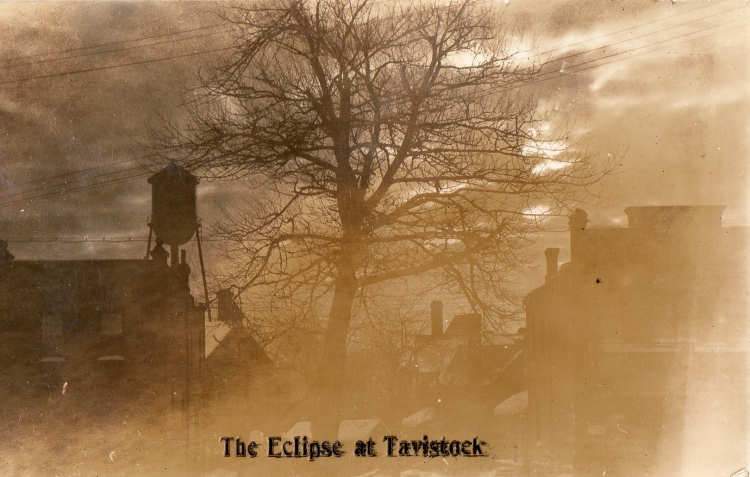Submitted by pbartlett@golden.net on

The Total Solar Eclipse of January 24, 1925
On the morning of January 24, 1925, Tavistock and area found itself in the path of a total solar eclipse. John Lemp Jr, local druggist and “astronomer”, was able to capture the event on film and in his store he sold postcards of the event.
Just as in 2024, the eclipse had been widely anticipated. The East Zorra correspondent to the Gazette said, “No doubt a lot of people who don’t know anything about it will be scared but just be calm and take a good look as we will never see it again in our days in Ontario.”
The path of totality was a sixty-mile strip that extended through Connecticut, parts of New York, Western Ontario, Michigan and Wisconsin. Readers were told that the total eclipse would last only two minutes but that stars would be visible during that time.
The most impressive sight would be the band of shadow approaching from the west at an enormous speed just before the face of the sun was entirely obscured.
“The last remaining minutes of the partial phases can be quite dramatic and beautiful”, writes one commentator. “The crescent of the Sun grows thinner as the Moon's shadow approaches. The abrupt darkness of totality is stunning and quite unlike you've ever seen. And the incredible solar corona is simply the most awe-inspiring naked-eye sight in all of nature. Certainly a most remarkable sight.”
Five scientists from the Dominion Observatory in Ottawa planned to go to Hamilton to take scientific observations of the eclipse. One of them may have been John Stanley Plaskett, Canada’s foremost astronomer. Jack had been born in East Zorra at Strathallan and was the leader of an expedition to study an eclipse in Labrador in 1905.
When the day of the eclipse finally came, there was widespread disappointment throughout the area as cloud cover prevented a clear view of “the most wonderful phenomenon”. Residents of Tavistock had gathered in the village square and had come equipped with smoked glass and camera film but were rewarded with just brief glimpses of the sun following totality. Some lucky ones were able to get fleeting glimpses of the stars during the period of total darkness which had swept over the community for a brief two minutes.
In the postcard of the eclipse sold by John Lemp, it is difficult to make out the sun because of the cloud cover but one can get a sense of the darkness that enveloped the community at 9 o’clock in the morning.
The report in the Gazette of the January 24, 1925 eclipse concluded with the comments, “the next total eclipse that will be visible here will be in October 2144. Here’s hoping the citizens of Tavistock on that day and generation—possibly our great-great-great grandchildren—may have better luck and a clearer view than did their forefathers.”